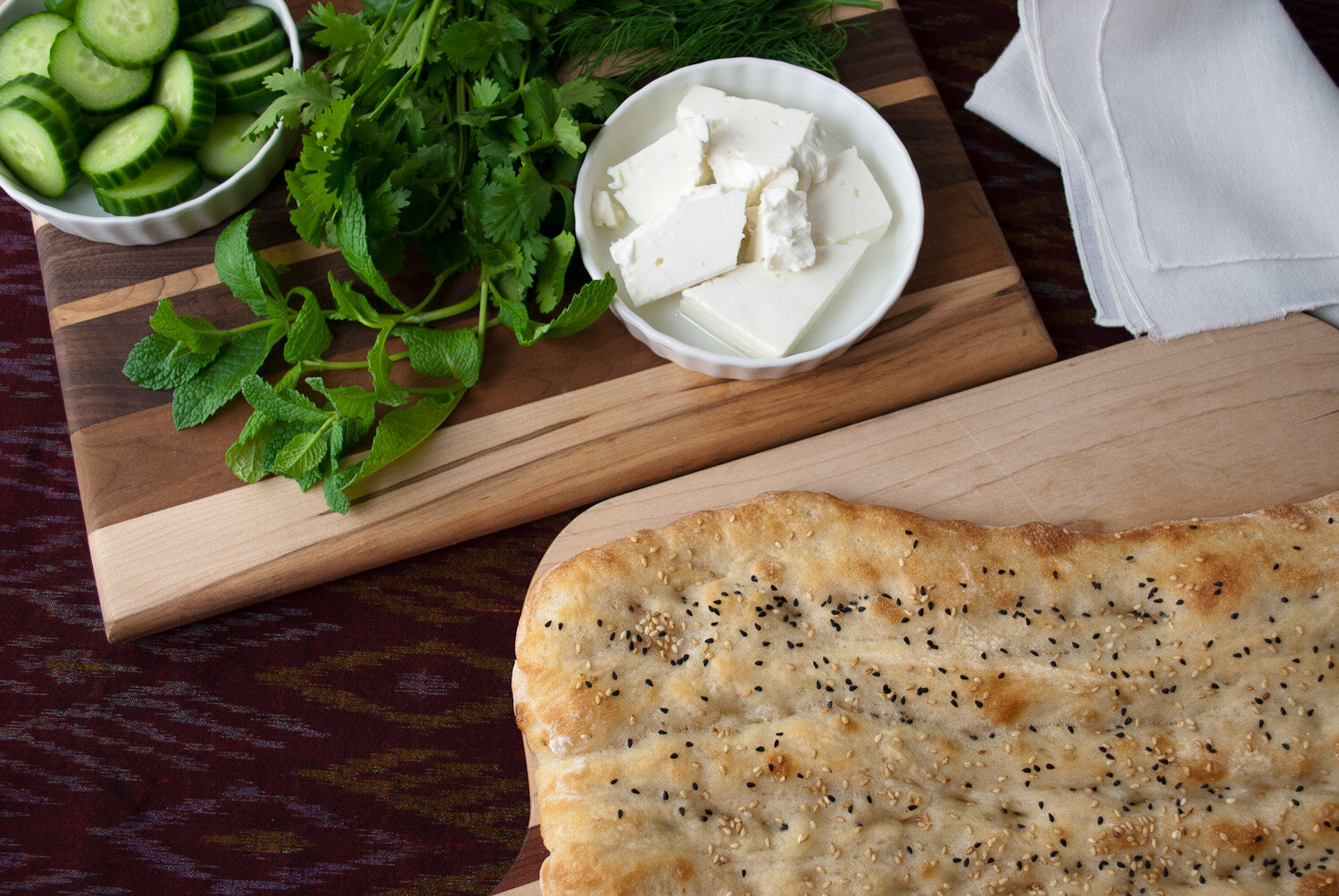Nan-e Barbari (Persian Flatbread)
I’ve been wanting to make this bread since I first saw it on the cover of The Hot Bread Kitchen Cookbook. With the rows of dimples and beautifully browned tops, sprinkled multi-colored seeds, it looked so tempting.
I am glad I found a good meal to pair it with! If you just want to serve it on it’s own, it is a perfect accompaniment to Sabzi Khordan (herb and feta plate), you can punch up this simple starter with some sliced onions or olives as well.
This bread also worked very well as a tear and dip bread for the Spinach Borani we made!
Nan-e Barbari (Persian Flatbread)
Makes 2 loaves
1 2/3 to 1 3/4 cups (379g to 397g) water, lukewarm
2 1/4 teaspoons active dry yeast or instant yeast
4 cups + 3 tablespoons (510g) Unbleached Bread Flour
1 1/2 teaspoons (9g) salt
semolina flour, for dusting (optional)
Glaze
2 teaspoons King Arthur Unbleached All-Purpose Flour or King Arthur Unbleached Bread Flour
1/2 teaspoon sugar
1/2 teaspoon vegetable oil
1/3 cup (74g) water, cool
Topping
1 teaspoon sesame seeds
1 teaspoon nigella seeds
1. To make the dough: Weigh your flour; or measure it by gently spooning it into a cup, then sweeping off any excess. Mix the water, yeast, flour, and salt until well combined. Knead the mixture — using your hands, a stand mixer, or your bread machine set on the dough cycle — until you've made a smooth, fairly soft dough (about 5 to 8 minutes if kneading by hand). The dough should barely clean the inside of the bowl, if you're using a stand mixer, perhaps sticking just a bit at the bottom.
2. Put the dough in a lightly greased large bowl, cover the bowl, and let the dough rise until it's nearly doubled in size, about 1 hour.
3. Transfer the dough to a lightly floured work surface. Gently deflate the dough, and divide it into two pieces.
4. Shape each piece into a rough log about 9" long. Tent (gently cover) the logs with lightly greased plastic wrap, and allow them to rest for 30 minutes.
5. Preheat the oven to 450°F. If you have a pizza stone, set it on the lowest rack or oven floor. If you'll be using a baking sheet, position a rack in the middle of the oven.
6. To prepare the glaze: Combine the flour, sugar, oil, and water in a small saucepan, bring to a bare boil, and cook over medium heat, stirring constantly, until the mixture thickens and coats the spoon; this should take less than a minute. Remove the glaze from the heat, and set it aside.
7. Working with one piece at a time, gently deflate the dough and pat/flatten it into a 14" x 5" rectangle. If you're using a pizza stone, transfer the dough to a semolina-dusted surface (a baker's peel is helpful here) or a piece of parchment paper. If you're not using a pizza stone, transfer the rectangle to a parchment-lined or lightly greased baking sheet.
8. Use your fingers (or the handle of a long wooden spoon) to press five lengthwise grooves into the dough. Press firmly, but don't cut through the bottom of the dough.
9. Spread half the glaze onto the dough, rubbing it all over. Sprinkle with half the seeds.
10. Slide the bread onto the stone and bake it for 15 to 18 minutes, until it's golden brown. If you're not using a stone, place the baking sheet on the rack in the middle of the oven and bake for the same amount of time, 15 to 18 minutes.
11. While the first loaf is baking, prepare the second loaf. Bake as directed.
12. Remove the bread, and cool it on a rack.
Serve warm, or at room temperature; traditional accompaniments are olives, cucumbers, herbs, and feta cheese.
Adapted from Hot Bread Kitchen and King Arthur Flour

